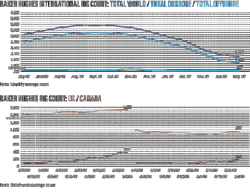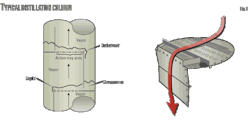With the turn of the year, Barclays Capital analysts reviewed major developments in global LNG trade for 2009 and offered insights for 2010 in a research note published in late January.
In 2009, said James Crandell, Biliana Pehilvanova, and Michael Zenker, weak Asian demand and growing global supply pushed a large number of spot LNG cargoes toward the Atlantic Basin. Rather than flooding US markets, as was feared, however, Europe absorbed most of the excess, as the continent rejected pipeline imports and filled storage to accommodate record LNG. European markets maintained a small price premium to the US.
Global oversupply last year pushed natural gas prices in Europe, the Americas, and Asia into convergence. In third-quarter 2009, spot LNG traded for $3.10-4.60/MMbtu around the world, said the analysts, the "tightest price range for spot global LNG in some time."
Supply growth could accelerate in 2010 as liquefaction plants that started up last year ramp towards full capacities this year and a few new plants begin operation.
Despite recovering global LNG demand, the size of expected supply increases again threatens to flood the world with LNG well more than potential growth in demand. And, barring extended cold weather, a global oversupply would promote greater interdependence for global gas prices this year.
Global supply
Natural gas prices in 2009 in Europe, the Americas, and Asia converged, thanks to a global glut of LNG (Fig. 1), and represented perhaps "the tightest connection of global gas prices ever."
The glut occurred despite underperforming supply. Global liquefaction capacity added a record 5.8 bcfd in nameplate capacity in 2009 (Fig. 2), but much of this came on in second-half 2009. Start-up problems delayed production from several new trains and lost production from existing plants offset much of the new additions.
Consequently, global LNG supply rose by roughly 1 bcfd year-over-year, large but well short of what markets anticipated.
This year, rapid growth of LNG supply is more certain. If all trains produce at capacity and 2010 plant additions come online as planned, global LNG supply would grow by more than 6 bcfd this year. But even this estimate may be too high, said Barclays Capital's analysts, given a history of delays and glitches.
More reasonable, they said, is incremental LNG production growth in 2010 of 4.5-5.5 bcfd. That would nonetheless be difficult for LNG markets to absorb. Restoration of Nigerian and Algerian LNG production poses further risks of fueling a global supply glut.
Demand
In the face of growing supply, economic slowdown and the resulting contraction in LNG and pipeline gas demand were "unfortunate."
Some countries last year, however, actually added LNG import capacity. Growth in Indian, Chinese, and Taiwanese imports offset some of the sharp decline in South Korea and Japan. Total Asian demand contracted by 3.4%, or 500 MMcfd, "less than economic indicators alone would suggest and far less than the market feared."
Growing regasification capacity in 2010 will support demand. Latin American countries received 31%, or 160 MMcfd, more LNG in 2009 than in 2008. Kuwait launched its first regasification terminal and quickly increased volumes to 500 MMcfd.
Most notable was the jump in LNG receipts in Europe. As several countries launched new regasification terminals, European imports grew steadily, aided by the relative strength of prices in Europe vs. the US. Estimates point to a record average 6.7 bcfd of LNG imports to Europe January-November 2009.
Nonetheless, the International Energy Agency estimates that through October 2009, natural gas consumption in European countries of the Organization for Economic Cooperation and Development dropped by 7.7%, or 4 bcfd. Increased LNG receipts were offset by a drop in pipeline imports, and aggregate (pipe + LNG) imports fell 10.3%, or 2.5 bcfd.
Stockpiling balanced the European market, while the pace of inventory growth set a record. The injection season extended well into November in Europe, similar to the US, and the winter season started with storage full.
Recovery
Global LNG demand for 2010 should grow, said the Barclays analysts. The global economy is on pace for a healthy recovery in 2010, yet the magnitude of expected expansions in LNG supply threatens to flood the world, outpacing potential increase in demand.
Assuming a strong, "but not full," recovery of Asian demand and taking into account new regasification terminals coming on in capacity-constrained markets, LNG imports in the Pacific Basin and the Middle East could grow by 2 bcfd this year, following a 5-MMcfd drop in 2009. South American and Mexican consumers could contribute 5-7 MMcfd growth in global demand.
With an estimated increase of global LNG supply next year of 5 bcfd, this would leave more than 2 bcfd of LNG aimed at US and European markets in 2010.
Last year, most excess spot LNG sailed to Europe. In 2010, however, European markets could struggle to expand LNG receipts. Although regas capacity allows for further gains, record inventories and already-low pipeline imports afford little flexibility for Europe to absorb LNG more than for immediate needs.
Nevertheless, LNG demand is "poised for recovery," and import demand (by pipe or boat) and stocks should grow in 2010. Ultimately, the need for LNG in Europe will depend not only on demand growth, but also on the interplay between pipeline imports, LNG, and storage change, all of which will influence the strength of European prices relative to the rest of the world.
North American markets face a glut of gas as well.
North America
Recently developed shale-gas resources have transformed the North American market to one in which demand is failing to match potential for supply additions. The US and Canada started this winter season with record gas in storage. Although balances will likely tighten this year, production continues to outpace expectations, while the recovery of demand marginally lags Barclays Capital's earlier projections.
The US and North America have already in 2010 received more LNG imports than for the same period in 2009. Even greater flows could result if European needs drop more than expected or global demand falters.
Weather could alter the outlook not only for North America, but also for global gas (and LNG) markets this year, as Europe and parts of Asia have also been unusually cold, said the analysts.
Most global LNG consumption is in the northern hemisphere and is, therefore, exposed to cold weather in many markets simultaneously. In Europe, UK demand jumped to daily records in January, pushing deliverability infrastructure and causing some shortages.
China in December and January was struggling to meet heating load in its northern provinces, as the country was hit by extended extreme cold. Such cold already helped reduce the inventory surplus around the world, said the analysis, although not yet enough to ensure a balanced market.
The cold could prove to be transient, but a continuation of below-normal temperatures across the globe over the course of the northern hemisphere's winter could substantially affect balances, potentially alleviating much of the oversupply and resetting regional balances and price differentials.
More Oil & Gas Journal Current Issue Articles
More Oil & Gas Journal Archives Issue Articles
View Oil and Gas Articles on PennEnergy.com



